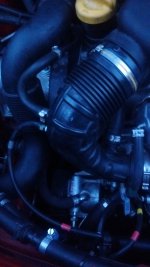- Joined
- Jan 14, 2016
- Messages
- 232
- Points
- 46
Vacuum/breather lines on t-jet air intake?
Hi,
I'm thinking of replacing the stock airbox+ducting of my Doblo T-Jet with a much simpler setup involving a pod airfilter.
I attached a picture of the stock pipe between the airbox and the turbo.
This pipe has to be replaced for my plans to work, so it is important I understand what's going on before I can design a replacement part in the shape I need.
Apart from the obvious airbox at one end and turbo at the other end I see 3 connections going to this pipe:
1. On the right there is a medium sized line which I think is part of the crankcase ventilation.
2. The smallest line on the bottom left goes to what I think is the boost controller
3. The slightly bigger line goes to the back of the engine.
(The boost recirculation valve goes to a connection on the airbox itself)
What are lines 2 and 3 for?
Edit: my theory after some research, confirmation/correction wanted:
2: recirculation of the leaked air from the boost controller? (If so I guess it's safe to just let the boostcontroller "leak" into the engine bay?)
3: fuel evap?
Greetings from Belgium,
Isabelle
Hi,
I'm thinking of replacing the stock airbox+ducting of my Doblo T-Jet with a much simpler setup involving a pod airfilter.
I attached a picture of the stock pipe between the airbox and the turbo.
This pipe has to be replaced for my plans to work, so it is important I understand what's going on before I can design a replacement part in the shape I need.
Apart from the obvious airbox at one end and turbo at the other end I see 3 connections going to this pipe:
1. On the right there is a medium sized line which I think is part of the crankcase ventilation.
2. The smallest line on the bottom left goes to what I think is the boost controller
3. The slightly bigger line goes to the back of the engine.
(The boost recirculation valve goes to a connection on the airbox itself)
What are lines 2 and 3 for?
Edit: my theory after some research, confirmation/correction wanted:
2: recirculation of the leaked air from the boost controller? (If so I guess it's safe to just let the boostcontroller "leak" into the engine bay?)
3: fuel evap?
Greetings from Belgium,
Isabelle
Attachments
Last edited:


